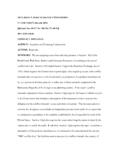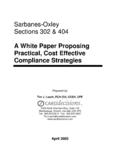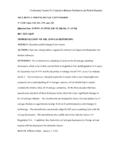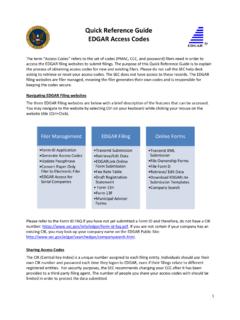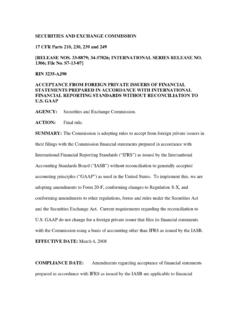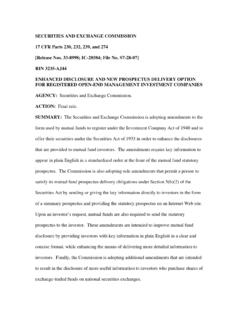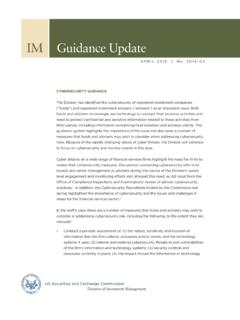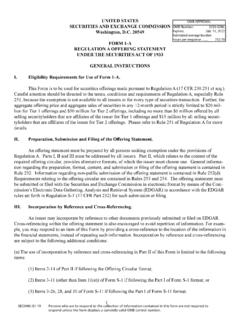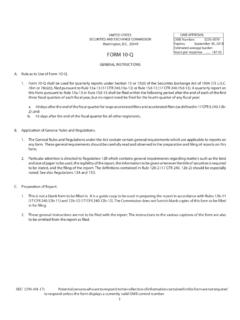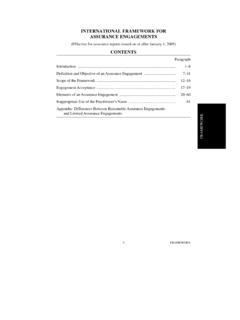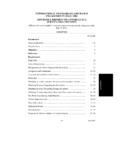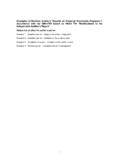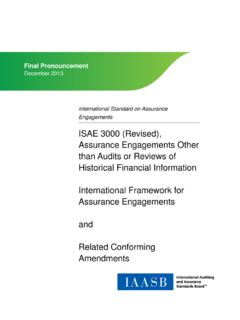Transcription of SECURITIES AND EXCHANGE COMMISSION 17 CFR PART 241 ...
1 SECURITIES AND EXCHANGE COMMISSION . 17 CFR PART 241. [RELEASE NOS. 33-8810; 34-55929; FR-77; File No. S7-24-06]. COMMISSION Guidance Regarding Management's Report on Internal Control Over Financial Reporting Under Section 13(a) or 15(d) of the SECURITIES EXCHANGE Act of 1934. AGENCY: SECURITIES and EXCHANGE COMMISSION . ACTION: Interpretation. SUMMARY: The SEC is publishing this interpretive release to provide guidance for management regarding its evaluation and assessment of internal control over financial reporting. The guidance sets forth an approach by which management can conduct a top- down, risk-based evaluation of internal control over financial reporting. An evaluation that complies with this interpretive guidance is one way to satisfy the evaluation requirements of Rules 13a-15(c) and 15d-15(c) under the SECURITIES EXCHANGE Act of 1934.
2 EFFECTIVE DATE: June 27, 2007. FOR FURTHER INFORMATION CONTACT: Josh K. Jones, Professional Accounting Fellow, Office of the Chief Accountant, at (202) 551-5300, or N. Sean Harrison, Special Counsel, Division of Corporation Finance, at (202) 551-3430, SECURITIES and EXCHANGE COMMISSION , 100 F Street, NE, Washington, DC 20549. SUPPLEMENTARY INFORMATION: The amendments to Rules 13a-15(c) 1 and 15d-15(c) 2 under the SECURITIES EXCHANGE Act of 1934 3 (the EXCHANGE Act ), which 1. 17 CFR (c). 2. 17 CFR (c). 3. 15 78a et seq. clarify that an evaluation of internal control over financial reporting that complies with this interpretive guidance is one way to satisfy those rules, are being made in a separate release.
3 4. I. Introduction Management is responsible for maintaining a system of internal control over financial reporting ( ICFR ) that provides reasonable assurance regarding the reliability of financial reporting and the preparation of financial statements for external purposes in accordance with generally accepted accounting principles. The rules we adopted in June 2003 to implement Section 404 of the Sarbanes-Oxley Act of 2002 5 ( Sarbanes-Oxley ). require management to annually evaluate whether ICFR is effective at providing reasonable assurance and to disclose its assessment to investors. 6 Management is responsible for maintaining evidential matter, including documentation, to provide reasonable support for its assessment.
4 This evidence will also allow a third party, such as the company's external auditor, to consider the work performed by management. ICFR cannot provide absolute assurance due to its inherent limitations; it is a process that involves human diligence and compliance and is subject to lapses in judgment and breakdowns resulting from human failures. ICFR also can be circumvented by collusion or improper management override. Because of such limitations, ICFR cannot prevent or detect all misstatements, whether unintentional errors or fraud. However, these inherent limitations are known features of the financial 4. Release No. 34-55928 (Jun. 20, 2007). 5. 15 7262. 6. Release No. 33-8238 (Jun. 5, 2003) [68 FR 36636] (hereinafter Adopting Release ).
5 Page 2. reporting process, therefore, it is possible to design into the process safeguards to reduce, though not eliminate, this risk. The reasonable assurance referred to in the COMMISSION 's implementing rules relates to similar language in the Foreign Corrupt Practices Act of 1977 ( FCPA ). 7. EXCHANGE Act Section 13(b)(7) defines reasonable assurance and reasonable detail as such level of detail and degree of assurance as would satisfy prudent officials in the conduct of their own affairs. 8 The COMMISSION has long held that reasonableness is not an absolute standard of exactitude for corporate records. 9 In addition, the COMMISSION recognizes that while reasonableness is an objective standard, there is a range of judgments that an issuer might make as to what is reasonable in implementing Section 404 and the COMMISSION 's rules.
6 Thus, the terms reasonable , reasonably, . and reasonableness in the context of Section 404 implementation do not imply a single conclusion or methodology, but encompass the full range of appropriate potential conduct, conclusions or methodologies upon which an issuer may reasonably base its decisions. Since companies first began complying in 2004, the COMMISSION has received significant feedback on our rules implementing Section 404. 10 This feedback included requests for further guidance to assist company management in complying with our ICFR. 7. Title 1 of Pub. L. 95-213 (1977). 8. 15 78m(b)(7). The conference committee report on the 1988 amendments to the FCPA. also noted that the standard does not connote an unrealistic degree of exactitude or precision.
7 The concept of reasonableness of necessity contemplates the weighing of a number of relevant factors, including the costs of compliance. Cong. Rec. H2116 (daily ed. Apr. 20, 1988). 9. Release No. 34-17500 (Jan. 29, 1981) [46 FR 11544]. 10. Release Nos. 33-8762; 34-54976 (Dec. 20, 2006) [71 FR 77635] (hereinafter Proposing Release ). For a detailed history of the implementation of Section 404 of Sarbanes-Oxley, see Section I., Background, of the Proposing Release. An analysis of the comments we received on the Proposing Release is included in Section III of this release. Page 3. evaluation and disclosure requirements. This guidance is in response to those requests and reflects the significant feedback we have received, including comments on the interpretive guidance we proposed on December 20, 2006.
8 In addressing a number of the commonly identified areas of concerns, the interpretive guidance: Explains how to vary evaluation approaches for gathering evidence based on risk assessments;. Explains the use of daily interaction, self-assessment, and other on-going monitoring activities as evidence in the evaluation;. Explains the purpose of documentation and how management has flexibility in approaches to documenting support for its assessment;. Provides management significant flexibility in making judgments regarding what constitutes adequate evidence in low-risk areas; and Allows for management and the auditor to have different testing approaches. The Interpretive Guidance is organized around two broad principles.
9 The first principle is that management should evaluate whether it has implemented controls that adequately address the risk that a material misstatement of the financial statements would not be prevented or detected in a timely manner. The guidance describes a top-down, risk-based approach to this principle, including the role of entity-level controls in assessing financial reporting risks and the adequacy of controls. The guidance promotes efficiency by allowing management to focus on those controls that are needed to adequately address the risk of a material misstatement of its financial statements. The guidance does not require management to identify every control in a process or document the business processes impacting ICFR.
10 Rather, management can focus its evaluation Page 4. process and the documentation supporting the assessment on those controls that it determines adequately address the risk of a material misstatement of the financial statements. For example, if management determines that a risk of a material misstatement is adequately addressed by an entity-level control, no further evaluation of other controls is required. The second principle is that management's evaluation of evidence about the operation of its controls should be based on its assessment of risk. The guidance provides an approach for making risk-based judgments about the evidence needed for the evaluation. This allows management to align the nature and extent of its evaluation procedures with those areas of financial reporting that pose the highest risks to reliable financial reporting (that is, whether the financial statements are materially accurate).
